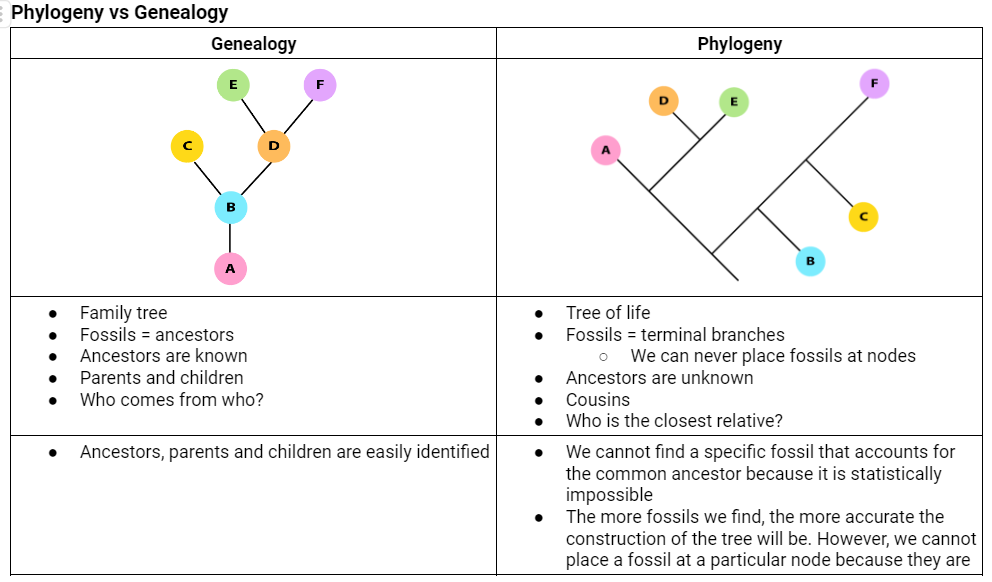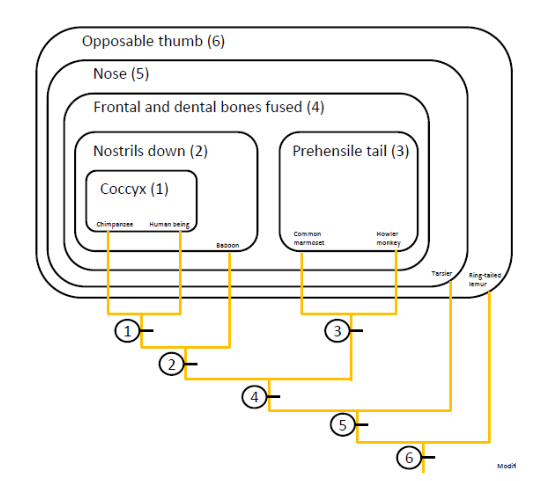Module 2: Evidences for Evolution + Classification and Phylogeny
1/85
There's no tags or description
Looks like no tags are added yet.
Name | Mastery | Learn | Test | Matching | Spaced |
|---|
No study sessions yet.
86 Terms
Fossil Records
Homology and Common Descent
Ontogeny
Branching Evolution
Vestigial Characters
Convergence
Suboptimal Designs
Biogeography
What are the 8 Evidences for Evolution?
Sedimentary Rocks
What rocks are used to look at the strata of different ages?
T
T or F: fossils in different strata have the different time period
T
T or F: The nearer the strata is to the surface, the younger the strata and the fossils located in it is.
There are gaps in evolutionary history. The more fossils are found, the less gaps there in the evolutionary history
What does incompleteness of fossil record mean?
Scientists discovered Archaefructus sinensis (ancient fruit) which was a specimen that shows intermediate characters between flowering plants and seed plants. It is NOT the ancestor of gymnosperms and angiosperms.
How were fossils utilized in explaining the evolutionary history of gymnosperms (seed plants) and angiosperms (flowering plants)?
T
T or F: intermediate forms allow us to understand connections between organisms. These fossils are not direct ancestors; instead they exist in parallel lineages.
T, it helps us understand when the characters appeared in evolution
T or F: fossils allows us to understand the chronical emergence of anatomical characters
When the characters arose
How the characters arose
Fossils are important in determining ___ and ___ the characters arose
Homology
This is when the structures look the same and share a common ancestor but they have different functions
Chiridian limb of dogs and birds.
Dogs: running
Birds: flying
Example of homology(dogs vs birds)
Ontogeny
Study of how organisms developed from early embryo stages
F, ontogeny does not summarize phylogeny. Just because we had tails and gills, does not mean that we were fish at one point. Ontogeny hints at a common ancestor when embryos of different species are homologous
T or F: Human embryo has similar characteristics to the embryos of other animals, e.g. the presence of gills and tails. That means that we were once a fish.
Ontogeny: how characters are related among different organisms during embryonic stage
Embryology: study of development of embryo at a particular lineage
Ontogeny vs Embryology
Evolution does NOT occur in a linear manner.
We can only infer the characters of ancestors but not the ancestors themselves.
What does it mean to have a branching evolution?
Vestigial Character
A lost or reduced organ
What is left of an evolution when an organism goes to a different lineage
Whales have remnants of pelvic structure as evidence of land colonization in the past.
Some lineages of snakes related to lizards have vestigial legs.
Examples of vestigial characters
Convergence
Presence of a trait that is similar in two different lineages and is a result of adaptations in similar environment
Artic foxes and birds have white coloration and have coverings that can insulate them. This is a result of being exposed to the same environment. They had they same survival strategy.
Example of convergence
T
T or F: Having suboptimal designs show that evolution is not always efficient. It also shows similarity in characters of different organisms, implying a common ancestor
Biogeography
Study of patterns of geographic distribution of organisms and the factors that determine those patterns
Phylogeny
Phylo (phylum): lineages
Geny (genesis): origin
It means origin of lineages
Phylogeny
It is the historical pattern of descent of organized beings
Phylogeny
It is a tree that illustrates the genesis of phyla. It is a graphic representation of evolutionary relationships between organisms.
Phylogeny
It is a tree that illustrates sister-group relationships, or “who is most closely related to whom“ or the degree of evolutionary relatedness
Phylogeny
It is a tree that provides secondary homologies
Hatch marks
Represents a homologous characteristic shared by all the groups to the right of the mark
T
T or F: there is not “TOP“ to a tree because a phylogenetic tree can be represented in multiple ways or directions. There is only temporal direction
Resolved tree
A phylogenetic tree where there is resolution at each node.
There are two branches at each node.
Ancestors
Nodes in phylogenetic trees represent ____
Polytomy (unresolved tree)
A phylogenetic tree where there are more than two branches at a node.
In this tree, we cannot know which lineages are closer to each other
3 Realms of Life:
Archaea
Bacteria
Eukarya
Example of polytomy

Difference between genealogy and phylogeny
Clade: Monophyletic Groups
Grade: Paraphyletic Groups, Polyphyletic Groups
Clade vs Grade
Monophyletic group
A grouping that contains common ancestor and all of its descendants
Paraphyletic group
A grouping that contains ancestor and part of its descendants
Polyphyletic group
A grouping that does not contain common ancestor of all group members
Fish
What is a famous polyphyletic grouping system
Reptilia
What is a famous paraphyletic grouping
Systematics
The science of biological classification and of the evolutionary relationships among organisms
Cladistic
A method of analyzing characters and attempts to determine evolutionary sequence of characters
It determines while is plesiomorphic and apomorphic character states
Systematics
A phylogenetic classification expresses only the phylogenetic relationships among organisms determined using cladistic analysis
Character
A set of attributes
Anything that can be observed and measure in organisms
Character States
Every possible form a character can potentially display
Can be quantitative or qualitative
Plesiomorphic
Ancestral state of a character
Symplesiomorphic
Refers to a plesiomorphic character that is present in two or more taxa
Apomorphic
In a series of character state transformations, this is the derived state with reference to the ancestral state
Autapomorphic
Refers to a derived state of a character that is unique to one of the two groups
Not useful in classification since it only belongs to one lineage
Synapomorphic
Apomorphic character that is shared by two or more taxa or lineages
Homology
Shows same fundamental organization and same essential connections with neighboring organs, despite variations in appearance of these structures
Similarity among organs which is presumed to be inherited from a common ancestor
Homoplasy
A similarity among one or several species but this is not due to an inheritance from a common ancestor
Convergence
Parallelism
Reversion
3 Types of Homoplasy
1. Resemblance due to secondary homology
Resemblance is observed through phylogeny using implied parsimony analysis
2. Resemblance due to convergence
2 species sharing the same character state experienced 2 independent evolutionary events
Transformation occurs in the same direction
3. Resemblance due to reversion
Return to ancestral character
Transformation occurs in a different direction
Explain the 3 Different Categories of Resemblance
Homology
Similarly inherited from a common ancestor
EX: chiridian limb
Convergence
Similar attributes that appeared independently in different taxa as a result of being subjected into similar environmental forces
EX: dolphins and sharks’ hydrodynamic shape
Reversion
Derived character that returned into its plesiomorphic state
EX: Grasses, which emerged later in time, resemble woody plants rather than flowering plants since they can’t produce their own food
Classification
Construction of a meaningful link among objects that has the form of a hierarchical system.
The arrangement of living organisms into hierarchical groups according to a set of predefined groups
Domain
Kingdom
Phylum
Class
Order
Family
Genus
Species
System of classification
T
T or F: Binomial Nomenclature of the Linnaean Classification System is still being used today
Taxon
Group of recognized organisms found within different categories of hierarchical classification
T
T or F: Any clade can be considered as a taxon
Taxonomy
The science of the rules for classification of living organisms
The science of the theory and practice of classification (Mayr). It includes the recognition and identification of living organisms and their organization in a classification
Parsimony
Maximum Likelihood
Bayesian Inference
Neighbor Joining or Phenetic
4 Methods of Constructing Phylogenies

Construct its phylogenetic tree.

Occam
Parsimony was attributed to a 14th century monk named _____
Parsimony
It is a method of phylogeny construction that, given all possible dendrograms, retains the one with the lowest number of required evolutionary events.
Hypothesis 1
Which is more parsimonious out of the 2?

Cladogenesis and Anagenesis
Convergent and Parallel Evolution
Mosaic Evolution
Heterochrony
Exaptation
Adaptive Radiation
6 Patterns of Evolution
Cladogenesis
Pattern of evolution that results in the formation of a new clade
One or more species arising from one original species
Anagenesis
Pattern of evolution that shows slow change within one species
It does not result in speciation
T
T or F: Anagenesis leads to variation in character states within a species. Cladogenesis happens when a variation leads to the formation of new species.
Convergent Evolution
Shared organ that functions similarly in two different or very distant lineages that do not share common ancestry
Parallel Evolution
Shared organ that functions similarly in closely related lineages
T
T or F: both convergent and parallel evolution lead to homoplasy
Complex eye: molluscs and mammals
The eye complex of octopus and human have same function but characters are not evolutionarily related
Digger limb: insect and mammals
Presence of digger limbs in crickets and moles; but, they don’t come from same ancestry
Examples of convergent evolution
In mammals,
Marsupial mammals: develop their young outside their bodies
Placental mammals: develop their young from within their bodies
Example of parallel evolution
Parallel | Convergent |
|---|---|
closely related taxa | distantly related taxa |
homologous → orthologous | non-homologous genes |
similar changes in gene » similar phenotype | different changes in same gene » similar phenotype |
Differences between parallel and convergent evolution
Mosaic Evolution
This states that not all characters arise or change at the same time
T
T or F: The emergence of bipedalism did not happen in one instance or linearly. It went through several transitions + occurred in a branching manner
Heterochrony
A change in the relative rate or timing of a developmental event in an organism relative to when that event in its ancestor
Shows the impact of developmental genes in creation of new species
Neoteny or Paedomorphosis
It means retaining the juvenile characters of adulthood
HOX gene
Neoteny is a result of a mutation in the ___ ___ which does not allow some character traits to develop in adulthood
Unlike chimpanzees, adult human skulls retained similarities fetus skulls allowing bipedalism
The insertion of spine in human skull allows optimal posture for walking upright
Salamanders retain their gills (juvenile characteristic) allowing them to grow in bodies of water.
Examples of neoteny/paedomorphosis
Exaptation
Structures evolve for a particular context but are co-opted for another function
Tiktaalik had fins for aquatic environment. Eventually, its fins were used to aid in walking on land. This is the chiridian limb.
The feathers of bird were initially used for warmth. Now, some use it for flight.
Examples of exaptation
Adaptive Radiation
It occurs when organisms are able to rapidly diversify and adapt to different niches